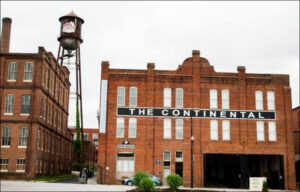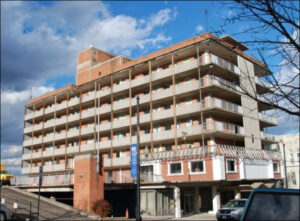
In Part II of his extended essay on the revitalization of downtown Danville, Va., The Atlantic magazine writer James Fallows dates the beginning of the city’s revival to the decision to demolish The Downtowner, a classic example of atrocious 60s-era architecture. In retrospect, it now obvious that the “modernist” architecture of the 50s and 6os was so hideous that it is not only not worth preserving, it is a blight. Or, as Fallows put it: “Most people believed that the old buildings had timeless-classic potential, and the Downtowner did not.”

When the city took the wrecking ball to the Downtowner in 2012, only 400 or so people worked or lived in the downtown tobacco warehouse district now known as the River District. After several years the renovation and retrofit of old industrial buildings, the number now stands at 6,000.
Classic architecture (even if it is industrial architecture) + a traditional downtown street grid + views of the Dan River have proved to be a winning combination. Who ever would have thought that Danville would reinvent itself as a center of walkable urbanism? But it has, and therein lies its hope for sustainable economic growth.
Danville has long epitomized Virginia’s “rust belt” economy, built on tobacco, textiles and furniture and devastated by globalism and factory automation. Efforts to stimulate a turnaround seemed dim given the city’s acute disadvantage in the competition for knowledge workers and the employers that covet them. America’s small metros (including Danville’s) can’t begin to match the depth and scope of skilled/educated workers found in large metros, much less the kind of economic synergies associated with industry clusters and innovation ecosystems.
But it turns out that Danville does have something the world wants: walkable urbanism. While Danville cannot compete on the size and quality of its labor force, it can offer walkable urbanism at lower prices and in a far less congested setting than found in large metros. Danville won’t appeal to most high-tech employers, not by a long shot. But in a low-unemployment economy in which corporations are desperate for employees, the city now has something to offer that other small cities do not.
Fallows attributes much of Danville’s revival to Virginia’s tax breaks for the renovation of historical structures.
In Danville, the tax policies that matter have been from two states, and the federal government. The states are Virginia, which offers builders a 25% tax credit for construction cost on historic-preservation projects like those in Danville — and neighboring North Carolina, which also had such a program but cut it back substantially five years ago. Both state credits come on top of a 20% federal tax credit for preservation projects, and in effect they dramatically reduced the capital costs for developers interested in restoring warehouses, abandoned factories, old shops, etc. (Do such tax preferences amount to “picking winners”? Sure. But in a tax regime that includes provisions like the carried-interest deduction for hedge-fund managers, I’ll defend the public benefits of this preference any time.)
The Virginia program fostered renewal efforts like those in Danville (and Roanoke and Lynchburg and Charlottesville and elsewhere). The cuts in the North Carolina program (though later partially reversed) enticed developers like those who had transformed tobacco and textile works in Durham and Winston-Salem to look out of state. Virginia was right next door.
Hopefully, the Virginia Tobacco Revitalization Commission, which still has millions of dollars of funds to grant, will learn something from Danville’s experience. Subsidizing investment by transient corporations who have no long-term commitment to the region is not a sustainable economic development strategy. Ten or 15 years later and, poof, many of these manufacturers and call centers will be gone. Rather, the commission should focus on building communities with sufficient size and wealth of assets that they can compete in the Knowledge Economy. Centers of walkable urbanism like Danville and Abingdon can become local magnets for growth, capturing skilled/educated workers and corporate investment that the region might otherwise lose to larger metros. The key is creating places where knowledge workers can envision living, working and building businesses over the long haul.

Leave a Reply
You must be logged in to post a comment.